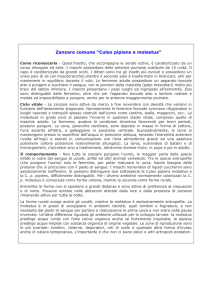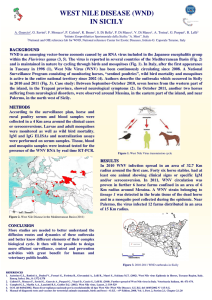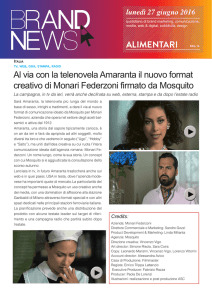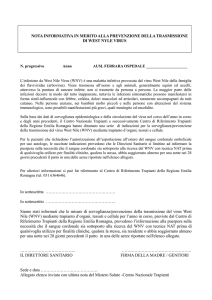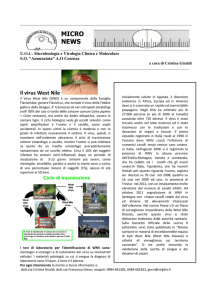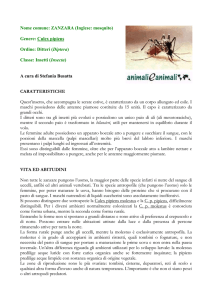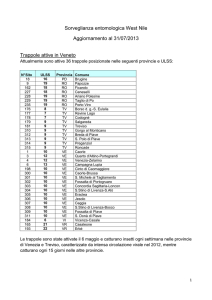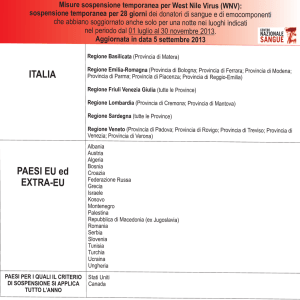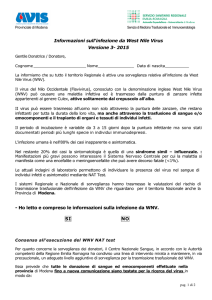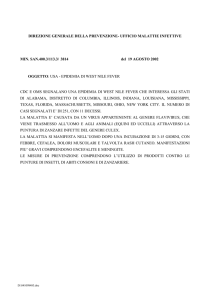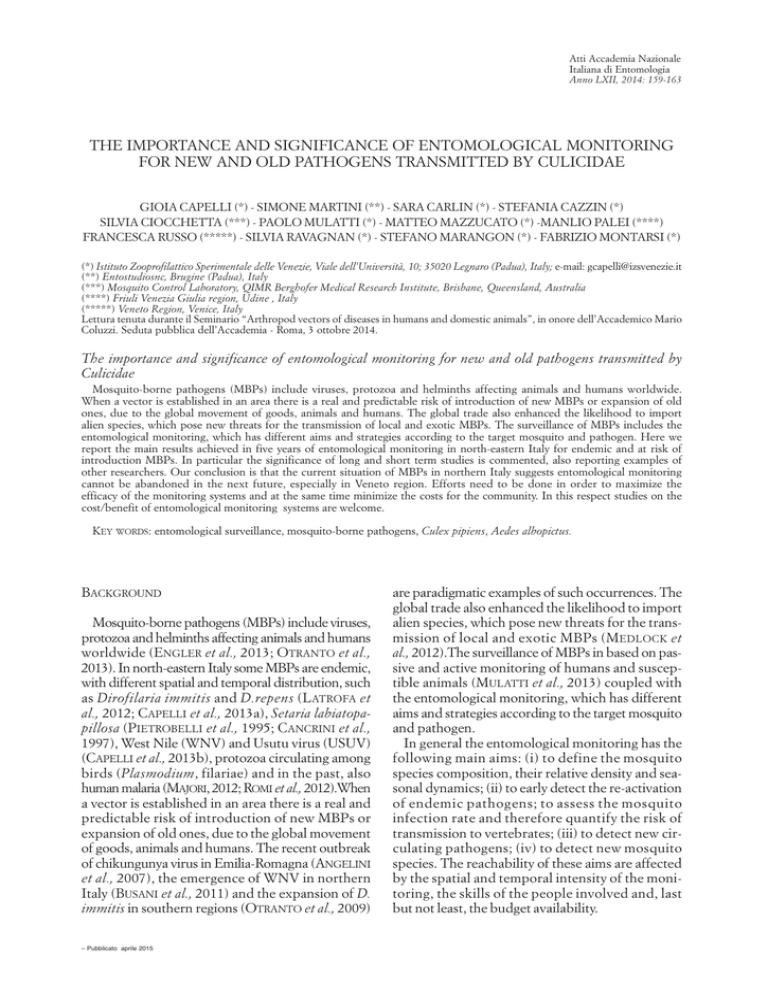
Atti Accademia Nazionale
Italiana di Entomologia
Anno LXII, 2014: 159-163
THE IMPORTANCE AND SIGNIFICANCE OF ENTOMOLOGICAL MONITORING
FOR NEW AND OLD PATHOGENS TRANSMITTED BY CULICIDAE
GIOIA CAPELLI (*) - SIMONE MARTINI (**) - SARA CARLIN (*) - STEFANIA CAZZIN (*)
SILVIA CIOCCHETTA (***) - PAOLO MULATTI (*) - MATTEO MAZZUCATO (*) -MANLIO PALEI (****)
FRANCESCA RUSSO (*****) - SILVIA RAVAGNAN (*) - STEFANO MARANGON (*) - FABRIZIO MONTARSI (*)
(*) Istituto Zooprofilattico Sperimentale delle Venezie, Viale dell’Università, 10; 35020 Legnaro (Padua), Italy; e-mail: [email protected]
(**) Entostudiosnc, Brugine (Padua), Italy
(***) Mosquito Control Laboratory, QIMR Berghofer Medical Research Institute, Brisbane, Queensland, Australia
(****) Friuli Venezia Giulia region, Udine , Italy
(*****) Veneto Region, Venice, Italy
Lettura tenuta durante il Seminario “Arthropod vectors of diseases in humans and domestic animals”, in onore dell’Accademico Mario
Coluzzi. Seduta pubblica dell’Accademia - Roma, 3 ottobre 2014.
The importance and significance of entomological monitoring for new and old pathogens transmitted by
Culicidae
Mosquito-borne pathogens (MBPs) include viruses, protozoa and helminths affecting animals and humans worldwide.
When a vector is established in an area there is a real and predictable risk of introduction of new MBPs or expansion of old
ones, due to the global movement of goods, animals and humans. The global trade also enhanced the likelihood to import
alien species, which pose new threats for the transmission of local and exotic MBPs. The surveillance of MBPs includes the
entomological monitoring, which has different aims and strategies according to the target mosquito and pathogen. Here we
report the main results achieved in five years of entomological monitoring in north-eastern Italy for endemic and at risk of
introduction MBPs. In particular the significance of long and short term studies is commented, also reporting examples of
other researchers. Our conclusion is that the current situation of MBPs in northern Italy suggests entomological monitoring
cannot be abandoned in the next future, especially in Veneto region. Efforts need to be done in order to maximize the
efficacy of the monitoring systems and at the same time minimize the costs for the community. In this respect studies on the
cost/benefit of entomological monitoring systems are welcome.
KEY WORDS: entomological surveillance, mosquito-borne pathogens, Culex pipiens, Aedes albopictus.
BACKGROUND
Mosquito-borne pathogens (MBPs) include viruses,
protozoa and helminths affecting animals and humans
worldwide (ENGLER et al., 2013; OTRANTO et al.,
2013). In north-eastern Italy some MBPs are endemic,
with different spatial and temporal distribution, such
as Dirofilaria immitis and D.repens (L ATROFA et
al., 2012; CAPELLI et al., 2013a), Setaria labiatopapillosa (PIETROBELLI et al., 1995; CANCRINI et al.,
1997), West Nile (WNV) and Usutu virus (USUV)
(CAPELLI et al., 2013b), protozoa circulating among
birds (Plasmodium, filariae) and in the past, also
human malaria (MAJORI, 2012; ROMI et al., 2012).When
a vector is established in an area there is a real and
predictable risk of introduction of new MBPs or
expansion of old ones, due to the global movement
of goods, animals and humans. The recent outbreak
of chikungunya virus in Emilia-Romagna (ANGELINI
et al., 2007), the emergence of WNV in northern
Italy (BUSANI et al., 2011) and the expansion of D.
immitis in southern regions (OTRANTO et al., 2009)
– Pubblicato aprile 2015
are paradigmatic examples of such occurrences. The
global trade also enhanced the likelihood to import
alien species, which pose new threats for the transmission of local and exotic MBPs (M EDLOCK et
al., 2012).The surveillance of MBPs in based on passive and active monitoring of humans and susceptible animals (MULATTI et al., 2013) coupled with
the entomological monitoring, which has different
aims and strategies according to the target mosquito
and pathogen.
In general the entomological monitoring has the
following main aims: (i) to define the mosquito
species composition, their relative density and seasonal dynamics; (ii) to early detect the re-activation
of endemic pathogens; to assess the mosquito
infection rate and therefore quantify the risk of
transmission to vertebrates; (iii) to detect new circulating pathogens; (iv) to detect new mosquito
species. The reachability of these aims are affected
by the spatial and temporal intensity of the monitoring, the skills of the people involved and, last
but not least, the budget availability.
– 160 –
ENDEMIC PATHOGENS PND CULEX PIPIENS L.
The north-eastern part of Italy (Veneto and Friuli
Venezia Giulia regions) seems to be particularly
suitable for the mosquito survival, likely due to its
climate, landscape and abundance of
wild/domestic animals. After the emergence of
WNV in 2008 (MACINI et al., 2008; BUSANI et al.,
2011), several entomological studies were implemented, including long term monitoring systems
and short term studies to answer specific questions.
For long term monitoring, a range of 24-66 CDCCO2 traps were activated weekly or fortnightly from
May to October 2009-2013. The mosquitoes were
screened by RT-PCR for Flaviviridae (RAVAGNAN et
al., 2011). More than 700,000 mosquitoes were collected, being Cx.pipiens the most abundant (80%)
followed by Ochlerotatus caspius and Aedes vexans.
Cx. pipiens was the only vector of WNV and USUV
in this area.
From 2010 to 2013, the WNV positive samples
were characterized by partial sequencing of NS5
and NS3 genes.The phylogenetic analyses showed
the occurrence of WNV lineage 1 and 2, and of
two different strains of WNV-1 that have been
circulating with different spatial and temporal
patterns.This highlights that new viral
introductions have occurred in few years and also
indicates the capability of these viruses to become
endemic and to rapidly evolve and emerge in
different sites (CAPELLI et al., 2013b;RAVAGNAN et
al., 2014).
Mapping, modeling and spatial analyses were
done using the entomological data to identify
correlations with climate, landscape, animal and
human infections (M ULATTI et al., 2014). The
results showed for the first time that the
contribution of density-dependence in regulating
vector population growth was greater than any
other environmental factor on its own. Overall the
most significant predictors of Cx.pipiens dynamics
included length of daylight, population density
and temperature in the 15 days prior to sampling.
Precipitation, number of rainy days and humidity
had limited importance. Also linear models
detected significant relationships between WNV
in humans and mosquitoes. Spatial analysis
detected clusters of WNV occurrences for all the
hosts, identifying an area where to focus
surveillance and promptly detect WNV reactivation (MULATTI et al., 2013).
Beside annual monitoring, short term studies
were organized. In one site, captures with CDC
and gravid traps were done every 2hrs for 24hrs all
over the season. The “dial activity” showed that
Cx.pipiens changed its host searching activity
according to the season and highlighted the period
of the day at major risk of Cx. pipiens biting
(MONTARSI et al., 2015). This may help to target
personal protection against mosquitoes based on
the higher risk of human bite and WNV
transmission.
In other three sites pre- and post-disinfestation
captures were done (CARLIN et al., 2014).In only
one site a significant mosquito reduction (75%)
was achieved. The success of the control measures
in reducing Cx.pipiens density varied according to
the methods used, calling for the need of
harmonic guidelines for disinfestation procedures.
This may help to choose the most effective method
for mosquito control in case of emergency.
The host preference of Cx.pipiens was assessed
by PCR blood meal analysis of fed females and
human landing captures (MONTARSI et al., 2014).
Cx.pipiens fed preferentially on birds (76%),
mainly blackbird, sparrow, magpie and collared
dove, indicating possible bird targets for a better
WNV surveillance. The low biting rates of humans
and the absence of detection of human blood into
mosquitoes in the sites examined confirm that Cx.
pipiens is scarcely attracted by humans. The results
of this study could explain the relative low
incidence of WNV clinical cases in horses and
humans compared to other infected areas of
eastern Europe and USA. The data provided are
also of importance for WNV transmission risk
models in the area affected.
PATHOGENS AT RISK
(SKUSE)
OF INTRODUCTION AND
AEDES
ALBOPICTUS
In Italy every year a variable number of human
imported dengue and chikungunya cases are
reported (GOBBI et al., 2012). If these cases occur
in summer in an area infested by the tiger
mosquito the risk of transmission is real and
increases according to the density of the
mosquitoes and people. Consequently, the
knowledge of the degree of the infestation in an
area is pivotal to promptly intervene with the
disinfestation actions according to the National
Program of Surveillance. The best examples of a
large scale entomological monitoring is the one set
up in the Emilia Romagna region, where urban
areas are constantly monitored by more than 2,700
ovitraps (CARRIERI et al., 2011). Using the series of
historical data, the mean number of eggs laid in
ovitraps were compared to different estimates of
adult mosquito abundance, human landing
collection and number of bites declared by
citizens. It was then possible to calculate a disease
– 161 –
risk threshold in terms of number of eggs per
ovitrap above which an arbovirus epidemic may
occur (CARRIERI et al., 2012).
DETECTION OF NEW SPECIES
In Veneto region the entomological monitoring
for the tiger mosquito allowed the detection of
Aedes koreicus (Edwards), a new invasive
mosquito species (CAPELLI et al., 2011), potential
vector of arboviruses and filariae. The biology and
ecology of this mosquito need to be studied
(M ONTARSI et al., 2013), such as the host
preference (CAZZIN et al., 2014) and the vector
competence for helminthes and viruses. Invasive
Aedes species may pose new threats for animal and
human health (MEDLOCK et al., 2012). For more
details see MONTARSI et al. in this issue.
THE RETROSPECTIVE STUDIES
When a vector monitoring system is set up for
years a consistent bank of samples is usually
stored. A sub-sample of the mosquitoes collected
in previous years was screened for Bunyaviridae.
Tahyna virus was isolated from Ochlerota tus
caspius (Pallas) in Veneto and Emilia Romagna
Regions and Batai virus from Anopheles
maculipennis s.l. (Meigen) in Emilia Romagna only
(CALZOLARI et al., 2010, CAPELLI et al., 2014).
These findings help to enhance the preparedness
of the Health System to face the possible
emergence of these viruses. Using the DNA
extracted from mosquitoes in 2010 it was also
possible to map the distribution of D.immitis and
D.repens in mosquitoes in Veneto, giving new
insights on the risk of transmission for animals and
humans (LATROFA et al., 2012).
Another interesting example of the usefulness of
retrospective studies is the evidence of the
Schmallenberg virus (SBV) into Culicoides samples
stored in 2012 in Italy. In this case, it was possible
to demonstrate that SBV had circulated in at least
three Italian provinces since early September
2011, nearly 5 months prior the first detected case
in 2012 (GOFFREDO et al.,2013).
CONCLUSIONS
The current status of MBPs in northern Italy suggests that entomological monitoring cannot be
abandoned in the next future. In particular, Veneto
region is the only area of Italy where WNV has been
circulating continuously in animals, humans and
vectors since its emergence in 2008. Efforts need to
be done in order to maximize the efficacy of the
monitoring systems and at the same time minimize
the costs for the community. In this respect studies
on the cost/benefit of entomological monitoring
systems are welcome. For pathogens at risk of introduction a recent review of ROGERS et al. (2014) concluded that “The threat of dengue to Europe at
present is considered to be low but sufficiently
uncertain to warrant monitoring in those areas of
greatest predicted environmental suitability, especially in northern Italy and parts of Austria, Slovenia
and Croatia, Bosnia and Herzegovina, Serbia and
Montenegro, Albania, Greece, south-eastern
France, Germany and Switzerland, and in smaller
regions elsewhere”. The paradigmatic example of
chikungunya outbreak in Emilia Romagna region is
a lesson that we must not forget.
RIASSUNTO
Fra gli agenti patogeni trasmessi dalle zanzare vi sono
virus, protozoi ed elminti che possono infettare gli animali e
l’uomo in tutto il mondo. Se una specie di zanzara vettrice è
ben stabilita in un territorio vi è un alto rischio di introduzione di nuovi patogeni o di espansione di quelli già presenti, a causa del movimento globale delle merci, degli animali e degli esseri umani. Il commercio globale ha aumentato poi il rischio di importare specie aliene di zanzare
insieme agli agenti infettivi da loro trasmessi sia locali che
esotici. La sorveglianza del fenomeno si basa sul monitoraggio entomologico, che ha diversi obiettivi e strategie in
base alla specie di zanzara target e al tipo di patogeno trasmesso. Nella rassegna sono riportatii principali risultati
conseguiti in cinque anni di monitoraggio entomologico in
aree endemiche dell’Italia nord-orientale a rischio di introduzione di nuovi patogeni trasmessi dalle zanzare. In particolare viene discussa l’importanza di studi a lungo e breve
termine, riportando anche esempi di altri gruppi di ricerca.
Dall’analisi dei dati raccolti in nord Italia risulta che allo
stato attuale il monitoraggio entomologico non può essere
abbandonato in particolare nel Veneto. In futuro sarà necessario massimizzare l’efficacia dei sistemi di monitoraggio
allo scopo di ridurrei costi per la comunità.
REFERENCES
A NGELINI R., F INARELLI A.C., A NGELINI P., P O C.,
PETROPULACOS K., MACINI P., FIORENTINI C., FORTUNA
C., VENTURI G., ROMI R., MAJORI G., NICOLETTI L.,
R EZZA G., C ASSONE A., 2007- An outbreak of
chikungunya fever in the province of Ravenna, Italy. Euro Surveill.,12(9): E070906.1.
BUSANI L., CAPELLI G., CECCHINATO M., LORENZETTO M.,
SAVINI G., TERREGINO C., VIO P., BONFANTI L., POZZA
M.D., MARANGON S., 2011 - West Nile virus circulation in
Veneto region in 2008-2009. - Epidemiol. Infect., 139(6):
818-25.
C ALZOLARI M., B ONILAURI P., B ELLINI R, C AIMI M.,
D EFILIPPO F., M AIOLI G., A LBIERI A., M EDICI A.,
– 162 –
VERONESI R., PILANI R., GELATI A., ANGELINI P., PARCO
V., FABBI M., B ARBIERI I., L ELLI D., L AVAZZA A.,
CORDIOLI P., DOTTORI M., 2010 - Arboviral survey of
mosquitoes in two northern Italian regions in 2007 and
2008. – Vector Borne Zoonotic Dis., 10(9): 875-84.
C ANCRINI G., P IETROBELLI M., F RANGIPANE D I
REGALBONO A., TAMPIERI M.P., 1997 – Mosquitoes as
vectors of Setaria labiatopapillosa. - Int. J. Parasitol.,
Sep;27(9): 1061-4.
C APELLI G., D RAGO A., M ARTINI S., M ONTARSI F.,
SOPPELSA M., DELAI N., RAVAGNAN S., MAZZON L.,
SCHAFFNER F., MATHIS A., DI LUCA M., ROMI R. RUSSO
F., 2011 - First report in Italy of the exotic mosquito
species Aedes (Finlaya) koreicus, a potential vector of
arboviruses and filariae. - Parasit. Vectors, 4: 188.
C APELLI G., M ONTARSI F., R AVAGNAN S., C AZZIN S.,
MAZZUCATO M., MULATTI P., RUSSO F., MARANGON S.,
2014-How entomological studies can help the control of
mosquito-borne diseases: a five-years experience in northeastern Italy. - Parasit. Vectors 2014, 7(Suppl 1):O30.
Proceedings of the 1st Conference on Neglected Vectors
and Vector-Borne Diseases (EurNegVec): with
Management Committee and Working Group Meetings
of the COST Action TD1303.
CAPELLI G., RAVAGNAN S., MONTARSI F., FABRIZIO S.,
CAZZIN S., BONFANTI L., DI GENNARO A., PORTANTI O.,
MULATTI P., MONNE I., CATTOLI G., CESTER G., RUSSO
F., SAVINI G., MARANGON S., 2013b –Further evidence of
lineage 2 West Nile Virus in Culex pipiens of NorthEasternItaly. - Vet. Ital., 49(3): 263-8.
CAPELLI, G., FRANGIPANE DI REGALBONO, A., SIMONATO,
G., CASSINI, R., CAZZIN, S., CANCRINI, G., OTRANTO, D.,
P IETROBELLI M., 2013a -Risk of canine and human
exposure to Dirofilaria immitis infected mosquitoes in
endemic areas of Italy. - Parasit. Vectors, 6: 60.
C ARLIN S., M ARTINI S., S IGNORINI M., S CREMIN M.,
N ICOLARDI L., F ORONI M., R USSO F., C APELLI G.,
MONTARSI F., 2014 - Efficacy of disinfestation against
adult of Culex pipiens mosquitoes in West Nile virus
positive sites of north-eastern Italy. - Atti del XXVIII
Congresso Nazionale SoIPa:107.
CARRIERI M., ALBIERI A., ANGELINI P., BALDACCHINI F.,
VENTURELLI C., ZEO S.M., BELLINI R., 2011 -Surveillance
of the chikungunya vector Aedes albopictus (Skuse) in
Emilia-Romagna (northern Italy): organizational and
technical aspects of a large scale monitoring system. J.Vector.Ecol., Jun; 36(1): 108-16.
CARRIERI M., ANGELINI P., VENTURELLI C., MACCAGNANI
B., B ELLINI R.,2012 –Aedes albopictus (Diptera:
Culicidae) population size survey in the 2007 chikungunya
outbreak area in Italy. II: Estimating epidemic thresholds. J.Med.Entomol., 49(2): 388-99.
C AZZIN S., C IOCCHETTA S., R AVAGNAN S., D RAGO A.,
C ARLIN S., C APELLI G., M ONTARSI F., 2014- Host
preference of the invasive mosquito Aedes koreicus
[Hulecoeteomyiakoreica]. - Atti del XXVIII Congresso
Nazionale SoIPa: 80.
ENGLER O., SAVINI G., PAPA A., FIGUEROLA J., GROSCHUP
MH., KAMPEN H., MEDLOCK J., VAUX A., WILSON A.J.,
W ERNER D., J ÖST H., G OFFREDO M., C APELLI G.,
FEDERICI V., TONOLLA M., PATOCCHI N., FLACIO E.,
PORTMANN J., ROSSI-PEDRUZZI A., MOURELATOS S., RUIZ
S., VÁZQUEZ A., CALZOLARI M., BONILAURI P., DOTTORI
M., S CHAFFNER F., M ATHIS A., J OHNSON N., 2013
–European surveillance for West Nile virus in mosquito
populations. -Int. J.Environ. Res. Public Health., 10(10):
4869-95.
GOBBI F., BARZON L., CAPELLI G., ANGHEBEN A., PACENTI
M., N APOLETANO G., P IOVESAN C., M ONTARSI F.,
MARTINI S., RIGOLI R., CATTELAN A.M., RINALDI R.,
CONFORTO M., RUSSO F., PALÙ G., BISOFFI Z. VENETO
SUMMER FEVER STUDY GROUP, 2012 - Surveillance for
West Nile, dengue, and chikungunya virus infections,
Veneto Region, Italy, 2010. - Emerg. Infect. Dis.,
Apr;18(4): 671-3.
GOFFREDO M., MONACO F., CAPELLI G., QUAGLIA M.,
FEDERICI V., CATALANI M., MONTARSI F., POLCI A.,
PINONI C., CALISTRI P., SAVINI G.,2013 –Schmallenberg
virus in Italy: a retrospective survey in Culicoides stored
during the bluetongue Italian surveillance program. Prev.Vet.Med., 111(3-4): 230-6.
LATROFA M.S., MONTARSI F., CIOCCHETTA S., ANNOSCIA
G., D ANTAS -T ORRES F., R AVAGNAN S., C APELLI G.,
O TRANTO D., 2012 - Molecular xeno monitoring of
Dirofiliara immitis and Dirofiliara repens in mosquitoes
from north-eastern Italy by real-time PCR coupled with
melting curve analysis. - Parasit. Vectors, 5: 76.
MACINI P., SQUINTANI G., FINARELLI A.C., ANGELINI P.,
MARTINI E., TAMBA M., DOTTORI M., BELLINI R., SANTI
A., LOLI PICCOLOMINI L., PO C., 2008 -Detection of West
Nile virus infection in horses, Italy, September 2008. -Euro
Surveill., Sep 25;13(39).
MAJORI G.,2012 -Short history of malaria and its eradication
in Italy with shortnotes on the fight against the infection
in the Mediterranean basin. - Mediterr. J. Hematol.
Infect. Dis., 4(1): e2012016.
MEDLOCK J.M., HANSFORD K.M., SCHAFFNER F., VERSTEIRT
V., HENDRICKX G., ZELLER H., VAN BORTEL W., 2012 - A
review of the invasive mosquitoes in Europe: ecology,
public health risks, and control options. - Vector Borne
Zoonotic Dis.,12(6): 435-47.
MONTARSI F., DANESI P., MARTINI S., DRAGO A., CAZZIN S.,
FRANGIPANE DI REGALBONO A., CAPELLI G., 2014 Biting rate and host preference of Culex pipiens in an area
repeatedly affected by West Nile virus. Atti del XXVIII
Congresso Nazionale SoIPa: 79.
MONTARSI F., MARTINI S., DAL PONT M., DELAI N., FERRO
MILONE N., MAZZUCATO M., SOPPELSA F., CAZZOLA L.,
CAZZIN S., RAVAGNAN S., CIOCCHETTA S., RUSSO F.,
C APELLI G., 2013 - Distribution and habitat
characterization of the recently introduced invasive
mosquito Aedes koreicus [Hulecoeteomyiakoreica], a
new potential vector and pest in north-eastern Italy. Parasit. Vectors., Oct 10;6: 292.
MONTARSI F., MAZZON L., CAZZIN S., CIOCCHETTA S.,
CAPELLI G., 2015 - Seasonal and Daily Activity Patterns
of Mosquitoes (Diptera: Culicidae) Vectors of Pathogens in
North-Eastern Italy. -. Med. Entomol., 52(1): 56-62.
M ULATTI P., B ONFANTI L., C APELLI G., C APELLO K.,
LORENZETTO M., TERREGINO C., MONACO F., FERRI G.,
MARANGON S., 2013 - West Nile virus in north-eastern
Italy, 2011: entomological and equine IgM-based
surveillance to detect active virus circulation.- Zoonoses
Public Health, 60(5): 375-82.
MULATTI P., FERGUSON H.M., BONFANTI L., MONTARSI F.,
CAPELLI G., MARANGON S., 2014 - Determinants of the
population growth of the West Nile virus mosquito vector
Culex pipiens in a repeatedly affected area in Italy. Parasit.Vectors, 7: 26.
OTRANTO D., CAPELLI G., GENCHI C., 2009 - Changing
distribution patterns of canine vector borne diseases in
Italy: leishmaniosis vs. dirofilariosis. - Parasit. Vectors, 2
Suppl 1: S2.
OTRANTO D., DANTAS-TORRES F., BRIANTI E., TRAVERSA D.,
– 163 –
PETRI D., GENCHI C., CAPELLI G., 2013 - Vector-borne
helminths of dogs and humans in Europe. - Parasit.
Vectors, 16;6: 16.
PIETROBELLI M., FRANGIPANE DI REGALBONO A., SEGATO
L., TAMPIERI M.P., 1995 - Bovine setariasis in Friuli
Venezia Giulia. - Parassitologia, 37(1):69-74.
RAVAGNAN S., CAZZIN S., DA ROLD G., SALVIATO A., PALEI
M., RUSSO F., MONTARSI F., MARANGON S., CAPELLI G.,
2014 - Temporal and spatial patterns of different lineages
and strains of West Nile viruses in north-eastern Italy in
the mosquito vector Culex pipiens. - Atti del XXVIII
Congresso Nazionale SoIPa: 61.
RAVAGNAN S., GRANATO A., PORCELLATO E., CAZZIN S., DE
NARDI R., MAZZACAN E., DE BATTISTI C., MARANGON S.,
CAPELLI G., 2011 -Development of a one-step realtime
PCR assay for detection of flaviviruses in pooled
mosquitoes. In 5th Annual Meeting EPIZONE, 11–14
April 2011, The Netherlands.
ROGERS D.J., SUK J.E., SEMENZA J.C.,2014 -Using global
maps to predict the risk of dengue in Europe. -Acta Trop.,
129: 1-14.
R OMI , R., B OCCOLINI , D., M ENEGON , M., A ND G.
REZZA.,2012 -Probable autochthonous introduced malaria
cases in Italy in 2009-2011 and the risk of local vectorborne transmission. - Euro Surveill., 17: 20325.

